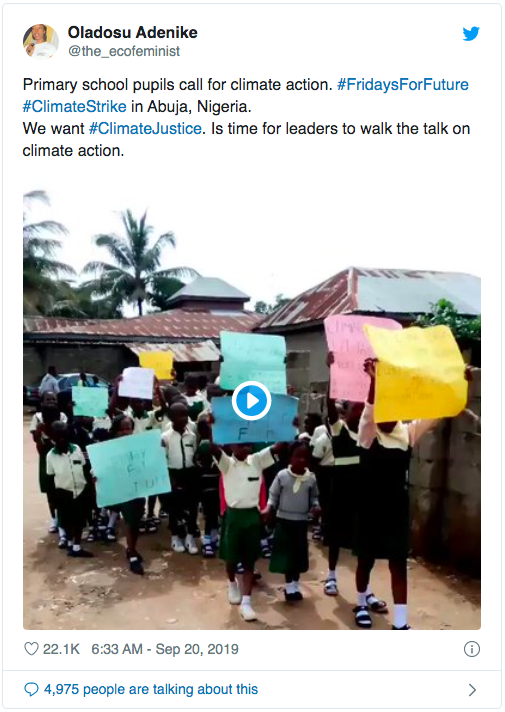How mobile money drives climate action.
The fight against climate change now as a human face: 16-year-old Greta Thunberg, whose passionate leadership has reinvigorated a global movement against the inaction of those in power.
“We demand a safe future,” says Greta in one of her memorable public addresses. “Is that really too much to ask?”
She spoke these words at a rally in New York City on September 20th, part of a global climate strike that had been ongoing since March and popularly dubbed #FridaysForFuture. The September 20th rally, which took place just days before the United Nations’ Climate Action Summit, flooded the international news cycle with images of teenagers skipping school to cram their city streets by the millions, demonstrating the scale and urgency of this protest from Boston to Hamburg to Athens and far beyond.
Among the stunning images from that day, there’s one that has stayed with me more than the rest. It comes from the capital city of Nigeria, where 300 students joined the global climate strike—far fewer than the thousands who marched in New York City, and yet arguably with far more at stake. 
For these children, climate change is a very real and immediate threat. It puts them at a greater risk of dying from preventable diseases like malaria. And because agricultural production is a vital lifeline for many of the 83 million Nigerians living in poverty, increasing incidents of flooding, drought and deadly heat waves represent imminent disaster.
On behalf of these children and others like them in developing regions around the world, we must act now. We must find creative solutions that will both slow the progress of climate change and deliver life-sustaining tools to those already suffering its impacts.
One of those tools is mobile money. Its role will become increasingly essential in a world committed to protecting the environment and the future of children worldwide. Here’s how.
Mobile money can slow the progress of climate change by making cleaner, healthier, more sustainable energy available to the world’s poorest communities.
A few years ago, Telepin partnered with MiBank, the South Pacific’s largest microfinance institution, to offer women in Papua New Guinea access to micro-loans via their mobile phones. The loans were used to finance solar energy installations in the women’s local communities, and once they were paid off, those communities could continue using solar energy for free (read more about that project here).
This initiative solved two problems: it gave women in isolated regions the training they needed to develop financial independence, and it helped communities replace expensive and polluting energy sources, like diesel and kerosene, with a safe and environmentally sustainable alternatives.
Initiatives like this one are becoming increasingly common. They take advantage of the ubiquity of mobile phones in developing regions to improve the fates of those most impacted by both climate change and financial exclusion. One by one, such success stories will fuel overall climate action initiatives and the economic strength of developing regions around the world.
Mobile money can enable financial resilience for those already impacted by climate change.
Our steeply rising world population represents the convergence of two threats: more people means more stress on the climate, which in turn means more adverse climate events that disportionately impact those in places where population growth projections are highest. Places like sub-saharan Africa, which could see its population reach 2.7 billion by 2060 (more than double what it is today). As this population grows, finding ways to help the people of sub-Saharan Africa survive the impacts of a climate under stress is absolutely necessary.
That necessity becomes even more urgent for those excluded from formal financial systems in sub-Saharan Africa. As explained by the World Economic Forum, “The poor lose a bigger share of their savings each time a flood hits because their money is not in bank accounts but in vulnerable housing, livestock or crops that are hard to move to safety.”
Mobile money is the answer to this extreme vulnerability. More than 17.5 million new mobile money accounts became active in sub-Saharan Africa last year, which now has the largest proportion of mobile money users in the world. By offering an affordable and convenient way for millions of households to save their money, insure their property and develop a sustainable safety net for times of struggle, these mobile money deployments can help families endure the impacts of climate change—even as those impacts become more and more severe in the face of a growing population.
CONCLUSION
At the United Nations Climate Summit a few days after that global climate strike on September 20th, Greta Thunberg told the U.N.’s Climate Action Summit, “I’m one of the lucky ones. People are suffering.”
She may well have been thinking of her compatriots on the other side of the world, those children in Nigeria and others like them, who weren’t just striking for a day off school—they were striking for their lives.
To help them and everyone else facing a precarious future, we must do something. We must gather every tool available to us, including mobile money applications, and create new opportunities to slow the progress of environmental degradation and empower those most impacted by it. In Greta’s words, “We already have the facts and the solutions. All we have to do is wake up and change.”
 Powered By Telepin: Tunisie Telecom Revolutionizes Its Charging System - Read More
Powered By Telepin: Tunisie Telecom Revolutionizes Its Charging System - Read More